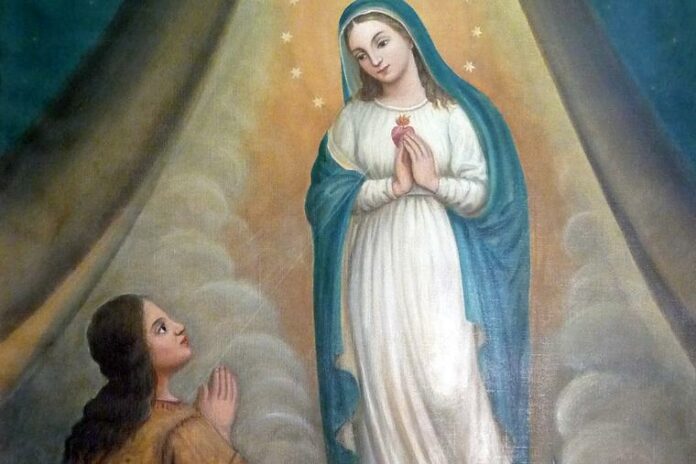Bu URN
Since last week, Catholic believers in Nalyamagonja-Manyangwa, Gayaza in Wakiso District, have flocked to a home where it’s claimed that the Virgin Mary, mother of Jesus, appeared during a rosary prayer gathering.
Alex Kamoga, a resident of the area who claims to have been present during the event, shared with our reporter that the vision first appeared as a reflection in a basin of water and later on the window of the house.
“Yes, she appeared, and since then, people have been coming here to pray,” said Kamoga.
In the initial days, the site reportedly drew large numbers of people, each eager to touch the “miraculous” window as they recited Marian prayers and sang hymns.
Witness accounts varied, with some describing Mary as a figure in white and blue clothing, while others saw a rainbow-like reflection in the window. However, a few others noted they did not witness any supernatural manifestation as described.
After the window where the appearance was reportedly seen was removed, a new claim emerged, this time of an appearance on a mirror on the door.
The Gayaza event follows a similar claim from Masindi District, where Catholics reported that Mary had appeared on Rwensa Hill in Nyangahya Sub-county, drawing the faithful in search of prayer, miracles, and blessings.
Amon Guzima, the chairman of Rwensa Village, is believed to be the first to witness the apparition while herding cattle. He and other persons claimed that the Mother of Jesus urged cohabiting couples to sanctify their unions through Holy Matrimony, calling for repentance and prayers for the nation.
In Catholic tradition, such supernatural experiences are referred to as Marian apparitions—a reported visual appearance of Mary that often carries messages or encouragements for the faithful.
However, authorities from the Hoima Diocese, Kampala Archdiocese, and Catholic Secretariat of the Uganda Episcopal Conference have refrained from confirming or denying the validity of the two events.
Rev Fr. Dr Pius Male Ssentumbwe, Chancellor of Kampala Archdiocese, emphasized that while the Church recognizes Marian apparitions, they require thorough investigation by theological experts. Rev Fr. Dr. Male added that, as a result, an investigation is underway, and the Archbishop will address the faithful in due time.
The archdiocesan Chancellor, however, cautioned the faithful to approach the claimed apparition with patience, warning them not to publicly declare such events, as only the local bishop can make such pronouncements after a thorough investigation. He noted that, at times, such claims may be driven by individuals with ulterior motives. Nevertheless, he encouraged the faithful to continue praying.
Rev Fr. John Baptist Kaganda, the national pastoral coordinator at Uganda Episcopal Conference, noted that while some Marian apparitions are validated by the Church, the majority do not receive recognition.
Kaganda who acknowledged to have heard of the Masindi and Gayaza claims, added that the Church moves cautiously in these matters, conducting extensive studies before making any declarations. “At this stage, no one can confirm the authenticity,” he said, adding that time and careful examination are essential to discern the truth.
He added that while the faithful should remain cautious, they may continue to pray. However, he advised against treating every claimed miracle or phenomenon as true, emphasizing that only the local bishop has the authority to make official pronouncements on such matters.
Throughout history, people worldwide have reported apparitions of Mary, often accompanied by accounts of miracles, messages of hope and healing, and calls to prayer. Although Marian’s apparitions are accepted by the Church, its teachings emphasize that Catholics are not obliged to believe in the purported phenomena.
One of the most famous Marian apparitions was recorded near the village of Fátima in Portugal, where Mary is said to have appeared six times to three children—Lucia dos Santos (aged 9) and her cousins Francisco and Jacinta Marto (aged 8 and 6, respectively)—while they were tending sheep in 1917.
Since then, millions of faithful, including many Ugandans, have made pilgrimages to the site. According to Encyclopedia Britannica, The Roman Catholic Church officially recognized the Fátima events as “worthy of belief” in 1930.
In all of Africa, there is only one Vatican-approved Marian apparition: Our Lady of Kibeho. This took place in the 1980s in Kibeho, Rwanda, where the Virgin Mary reportedly appeared to three young girls: Alphonsine Mumureke on November 28, 1981, Anathalie Mukamazimpaka on January 12, 1982, and Marie Claire Mukangango on March 2, 1982, with Mukangango reportedly experiencing visions for six months.
During these appearances, it is said that Mary’s messages to the girls emphasized reciting the rosary, fasting, penance, returning to God, sincerity, helping others, and praying the Rosary of the Seven Sorrows. The girls also had a prophetic vision of the Rwandan genocide, which occurred 13 years later.
According to the Catholic News Agency, while Bishop Augustin Misago of Gikongoro permitted public devotion to the apparitions in 1988, it wasn’t until 2001 that he and the Holy See declared the testimonies of the three witnesses to be authentic.
Today, the Kibeho Shrine is a pilgrimage site attracting faithful from around the world and includes a main church, chapel, rose garden, and other facilities for visitors.
In addition to the new claims of Marian apparitions, there have been many similar reports from various locations across Uganda. The most recent incident that garnered national attention occurred in Maracha District, attracting faithful from both Uganda and the Democratic Republic of Congo. However, like many others, this apparition did not receive approval from church authorities.
Vatican guide on Marian apparitions and mystical visions
This year the Vatican updated guidelines on discerning alleged supernatural events including Marian apparitions and mystical visions, streamlining the evaluation process for local bishops.
In the May 2024 document titled; Norms for Proceeding in the Discernment
of alleged supernatural phenomena, Cardinal Víctor Manuel Fernández, prefect of the Dicastery for the Doctrine of the Faith, outlined six possible outcomes for the investigations, from declaring an event as non-supernatural to authorizing devotion without endorsing its divine nature.
Under the new Norms, Only the Pope can declare an apparition as definitively supernatural, ensuring that the discernment process remains both thorough and carefully managed.



